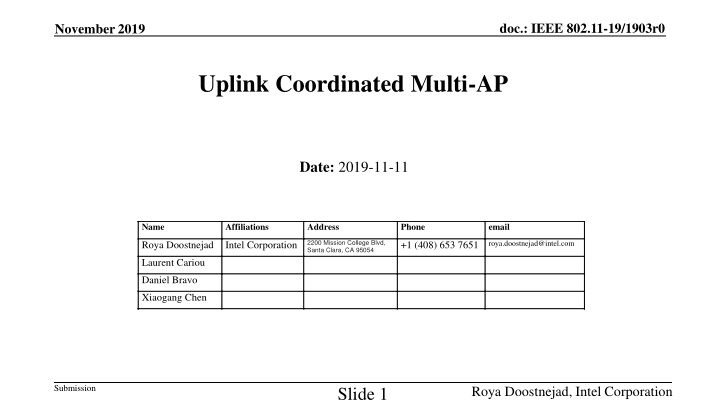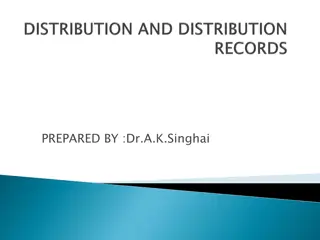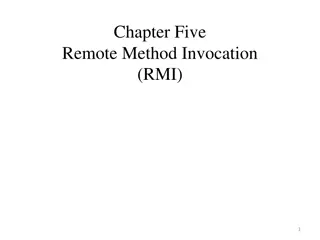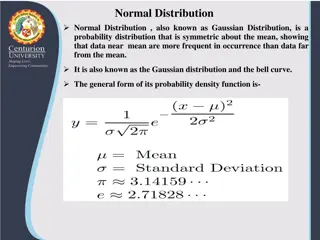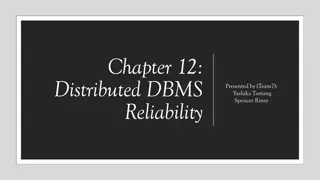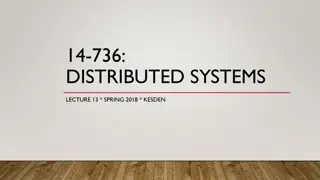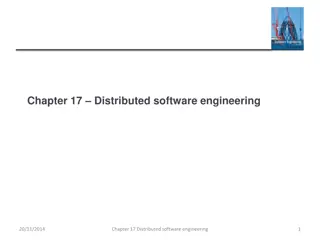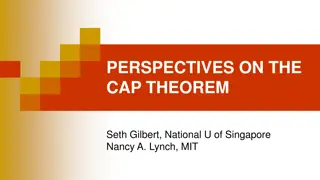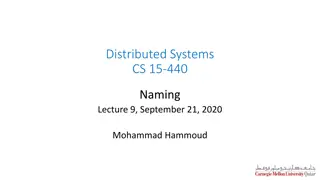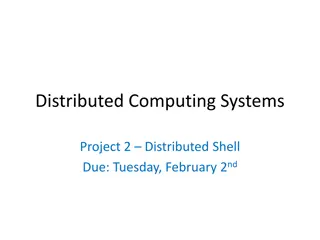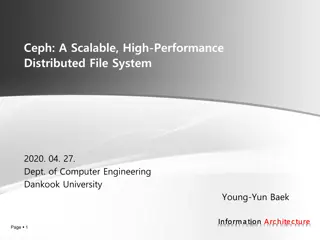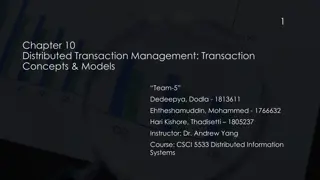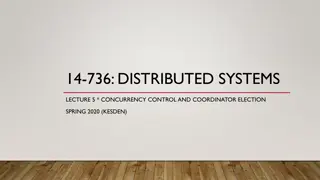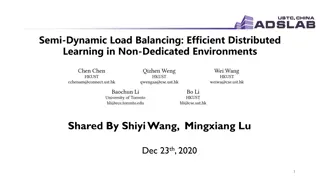Key Distribution and Management in Distributed Systems
This deck covers key distribution challenges in distributed systems, solutions like using a central keyserver, symmetric key distribution through Kerberos, Key Distribution Center (KDC), and the usefulness of a KDC. Kerberos trivia and its components are also discussed, shedding light on its development and implementation for secure communication.
Download Presentation

Please find below an Image/Link to download the presentation.
The content on the website is provided AS IS for your information and personal use only. It may not be sold, licensed, or shared on other websites without obtaining consent from the author.If you encounter any issues during the download, it is possible that the publisher has removed the file from their server.
You are allowed to download the files provided on this website for personal or commercial use, subject to the condition that they are used lawfully. All files are the property of their respective owners.
The content on the website is provided AS IS for your information and personal use only. It may not be sold, licensed, or shared on other websites without obtaining consent from the author.
E N D
Presentation Transcript
doc.: IEEE 802.11-19/1903r0 November 2019 Uplink Coordinated Multi-AP Date: 2019-11-11 Name Affiliations Address Phone email 2200 Mission College Blvd, Santa Clara, CA 95054 roya.doostnejad@intel.com Roya Doostnejad Intel Corporation +1 (408) 653 7651 Laurent Cariou Daniel Bravo Xiaogang Chen Submission Roya Doostnejad, Intel Corporation Slide 1
November 2019 doc.: IEEE 802.11-19/1903r0 Introduction Coordinated Multi-AP in Uplink (UL) o Enabling simultaneous transmission from multiple devices to multiple APs in the same frequency channel o Coordination between multiple non-collocated APs ??2 ??1 Int. o Each AP not only receives signals from the desired STAs but also from the co-channel interferers in the neighboring cells Anticipated gains: o Increasing Uplink (UL) Throughput in Managed Wi-Fi Networks o Facilitate Reliable Reception in UL/ Improve Cell Edge s performance o Reducing Latency as a result of Multi-AP operation Submission Roya Doostnejad, Intel Corporation Slide 2
November 2019 doc.: IEEE 802.11-19/1903r0 Introduction Multi-AP cooperation is expected to be easier to implement in UL than in the downlink (DL) OBSS Channel information is available in the network without resource-consuming feedback transmissions. o Synchronization requirements between APs may be less restricted o There are other constraints, such as the UL processing time and consequently time to send acknowledgement feedback as well as processing load across APs. Different levels of coordination may be realized based on the deployment and backhauling capabilities. Level of coordination may range from very limited information (scheduling) to significant amount of information (received samples for joint processing) exchange. Submission Roya Doostnejad, Intel Corporation Slide 3
November 2019 doc.: IEEE 802.11-19/1903r0 Introduction In this contribution we evaluate different schemes, which represent different level of coordination between APs, Compare simulation results, and analyze some implementation complexities: o Diversity Reception o Per-AP Interference Cancellation Similar concept/requirement as collaborative BF in DL. o Distributed SIC (DSIC) o Joint Reception (JR) Joint Multi-AP processing Submission Roya Doostnejad, Intel Corporation Slide 4
November 2019 doc.: IEEE 802.11-19/1903r0 Uplink Coordinated Multi-AP Schemes: Diversity Reception Diversity Reception (light coordination): No joint processing across APs Cell edge STA (?2) may be detected by each single AP (individually) and either APs who successfully receive data (?2) will send ACK. This provides extra route for reliability. Use Case: Cell Edge or Mission critical device with higher reliability requirement. The STA may send UL data and trigger multi-APs for collaborative reception in UL and ACK. Submission Slide 5 Slide 5 Roya Doostnejad, Intel Corporation
November 2019 doc.: IEEE 802.11-19/1903r0 UL Coordinated Multi-AP Schemes: Per-AP IC Per-AP Interference Cancellation (Per-AP IC): (medium coordination) No joint Multi-AP Processing/No data exchange across APs Multi-AP Coordination/ Joint Scheduling in UL transmission Each AP estimates the channel to its associated STAs and also estimates the interference and take spatially colored interference into account when calculating receive filters: Received signal at AP-i: ??= ????+ ? ????.??+ ? o ??? is interference link from STA-m (associated to AP-m) ? = ??? + ????? ?? ???? ??? MMSE-IRC Receiver Un-used spatial dimensions at an AP may be used to null the interference from OBSS. Limited backhaul capability, only some control signals are exchanged across APs Use Case: Lower density/interference network, central users with low path loss This scheme is also discussed in [1]. Slide 6 Submission Roya Doostnejad, Intel Corporation
November 2019 doc.: IEEE 802.11-19/1903r0 UL Coordinated Multi-AP Schemes: DSIC Distributed Interference Cancellation (DSIC): (Medium+ coordination) Single-AP decoding with successive interference cancellation (SIC) Data exchange is required across multiple APs o No joint Multi-AP processing Stage-1: Each AP decodes data from in-cell STAs and forward to other APs for interference subtraction o Channel estimation for in-cell and OBSS STAs o Receiver: MMSE, ML, Stage-2: Each AP performs second stage equalization o Removing interference data received from other APs High Speed Backhaul capability Use Case: Medium/high density, central/mixed users AP-2 AP-1 Stage-1 [STAs]2 [STAs]1 AP-2 AP-1 Stage-2 Cancel Int. from [STAs]1 Cancel Int. from [STAs]2 [STAs]2 [STAs]1 Submission Slide 7 Roya Doostnejad, Intel Corporation
November 2019 doc.: IEEE 802.11-19/1903r0 Uplink Coordinated Multi-AP Schemes: JR Joint Reception: (tight coordination) Received data from all STAs in OBSS are jointly processed Synchronization is required across APs Single-user (cell edge) / Multi-user Maximized Multi-AP Gain through joint array processing Higher front-haul rate, and stringent latency requirements, from participating nodes to central processor where the joint decoding takes place Use cases: Non-uniform distribution of STAs, High Interference o Higher Implementation Complexity ??1 ??2 Submission Slide 8 Slide 8 Roya Doostnejad, Intel Corporation
November 2019 doc.: IEEE 802.11-19/1903r0 Uplink Coordinated Multi-AP: Design Considerations Uplink Control Sequence for MU (High Level) The initiator AP will send a trigger frame to initiate the coordination. The APs IDs for all participating APs and STAs info may be identified in this trigger frame. After a SIFS time, all coordinated APs will send the exact same trigger frame (simultaneously) for UL MU transmission, identifying coordinated APs IDs, all the STAs (OBSS) info, etc. This will trigger data transmission in uplink from all STAs. Alternatively one trigger frame may be sent from initiator AP, assuming all STAs can hear the initiator AP Multiplexed in Time/ Frequency UL MU Trigger SIFS AP-1 [BA]1 SIFS SIFS UL MU Trigger [BA]2 AP-2 HE MU TB PPDU [STAs]1 HE MU TB PPDU [STAs]2 Submission Roya Doostnejad, Intel Corporation Slide 9
November 2019 doc.: IEEE 802.11-19/1903r0 Uplink Coordinated Multi-AP: Design Considerations Acknowledgement (ACK): Block ACK (BA) from all APs in coordinated set may be multiplexed in time or frequency In Per-AP IC and DSIC, each AP should send BA for its associated STAs In Diversity reception, if STA receives BA from any of the APs, that would be sufficient. In JR, one BA could be sent from master AP In JR, and DSIC, since some data exchange is required across APs, UL processing time should be taken into account. o If the backhaul speed is not high enough, Delayed BA may be required. BA policy may be indicated in UL trigger frame. Channel/ Interference estimation in UL: o STAs in collaborative set (OBSS) will send orthogonal training signals for channel estimation Submission Roya Doostnejad, Intel Corporation Slide 10
November 2019 doc.: IEEE 802.11-19/1903r0 Uplink Coordinated Multi-AP Summary Processing Time Concern/ (Delayed ACK/BA) Scheme Data Exchange across APs Backhaul Support Data transmission always initiated by a trigger from AP side Use Case SU Diversity No No No No Cell Edge/ Device with High Reliability Requirement Per-AP IC No No Yes No Un-used receive spatial dimension/ Interference from OBSS STAs DSIC Detected Symbols High Capacity/ Low latency Yes Likely Dense network/High interference JR/ SU Received samples after FFT High Capacity/ Low latency No Likely Cell Edge/ High Reliability Requirement JR/MU Received samples after FFT High Capacity/ Low latency Yes Very likely Dense network/High interference Non-uniform distribution of STAs Submission Roya Doostnejad, Intel Corporation Slide 11
doc.: IEEE 802.11-19/1903r0 Simulation Results Submission
November 2019 doc.: IEEE 802.11-19/1903r0 Simulation Set Up MATLAB Simulator Path Loss Model: IEEE Channel model D BW=20 MHz AP: 4 Tx/Rx antennas STA: Transmitting one spatial stream Noise floor: -89.9 dBm Receiver: MMSE Submission Slide 13 Slide 13 Roya Doostnejad, Intel Corporation
November 2019 doc.: IEEE 802.11-19/1903r0 Simulation Results, Example for 2 APs: Area Throughput STAs are moved vertically (1:41 m) If number of interfering STAs is lower than spatial degrees of freedom at each AP, per-AP IC performs the same as DSIC. In 2 APs case, JR and Per-AP IC provide ~2.5 and ~1.8 throughput gain compared to single-AP respectively. y=1:41 x=14 Submission Roya Doostnejad, Intel Corporation Slide 14
November 2019 doc.: IEEE 802.11-19/1903r0 PER Performance: 2 APs High interference/ Cell Edge Submission Roya Doostnejad, Intel Corporation Slide 15
November 2019 doc.: IEEE 802.11-19/1903r0 Simulation Results, Example for 2 APs: Area Throughput JR performs the same as per-AP IC because of power imbalance of STAs at receiving nodes. y=1:41 x=14 Submission Slide 16 Slide 16 Roya Doostnejad, Intel Corporation
November 2019 doc.: IEEE 802.11-19/1903r0 PER Performance: 2 APs STA1 STA3 Submission Slide 17 Slide 17 Roya Doostnejad, Intel Corporation
November 2019 doc.: IEEE 802.11-19/1903r0 Simulation Results: Example for 4 APs: Area Throughput /Packet Error Rate (PER) Number of antennas at each AP=4, Number of STAs=8 STAs are moved vertically (1:21 m) In high interfering scenarios, per-AP IC is not effective. In 4 APs case, JR and DSIC provide ~4 and ~2.5 throughput gain compared to single-AP respectively. y=1:21 x=10 Submission Slide 18 Slide 18 Roya Doostnejad, Intel Corporation
November 2019 doc.: IEEE 802.11-19/1903r0 PER Multi-AP Diversity Single-AP PER for 4 APs where STA is located in the cell edge. No joint processing/ No combining gain The packet from single STA is received by all 4 APs. PER will behave as the minimum among all APs. Submission Roya Doostnejad, Intel Corporation Slide 19
November 2019 doc.: IEEE 802.11-19/1903r0 Conclusion This contribution is for evaluation of Coordinated Multi-AP in Uplink whether the scheme is attractive and feasible. Analyzed different possible schemes and compared simulation results. JR provides the highest performance gain of multiple AP array processing/ interference cancellation but with the high cost of high speed backhaul requirement. Delayed BA may be required for JR. In Low-interference scenarios, Per-AP IC results close performance gains as JR For 2 APs, Per-AP IC results (1.5-2)x throughput gain depends on use case scenarios and path loss. In high-interference scenarios, Per-AP IC is not effective. In Single-user case with high reliability requirement, joint diversity reception may provide an additional path for data reception which improves reliability. Submission Slide 20 Slide 20 Roya Doostnejad, Intel Corporation
November 2019 doc.: IEEE 802.11-19/1903r0 References [1]: IEEE802.11-19/1594r2, Coordinated Beamforming/Null Steering Protocol in 802.11be . Submission Roya Doostnejad, Intel Corporation Slide 21
November 2019 doc.: IEEE 802.11-19/1903r0 Back up Submission Roya Doostnejad, Intel Corporation Slide 22
November 2019 doc.: IEEE 802.11-19/1903r0 Simulation Results, Example for 4 APs: Packet Error Rate (PER)/ Area Throughput y=1:41 x=14 Submission Slide 23 Slide 23 Roya Doostnejad, Intel Corporation
